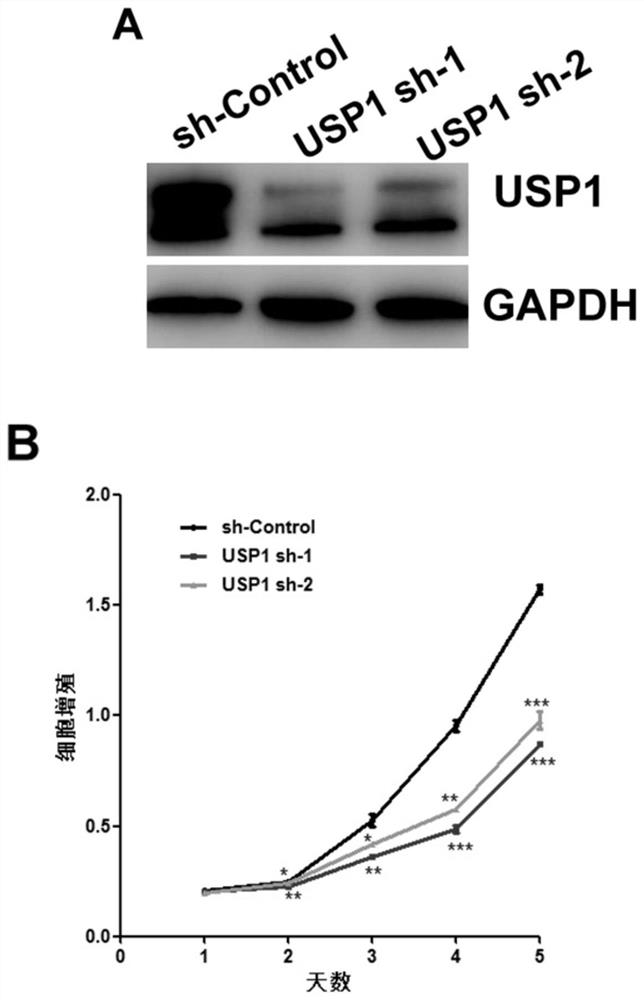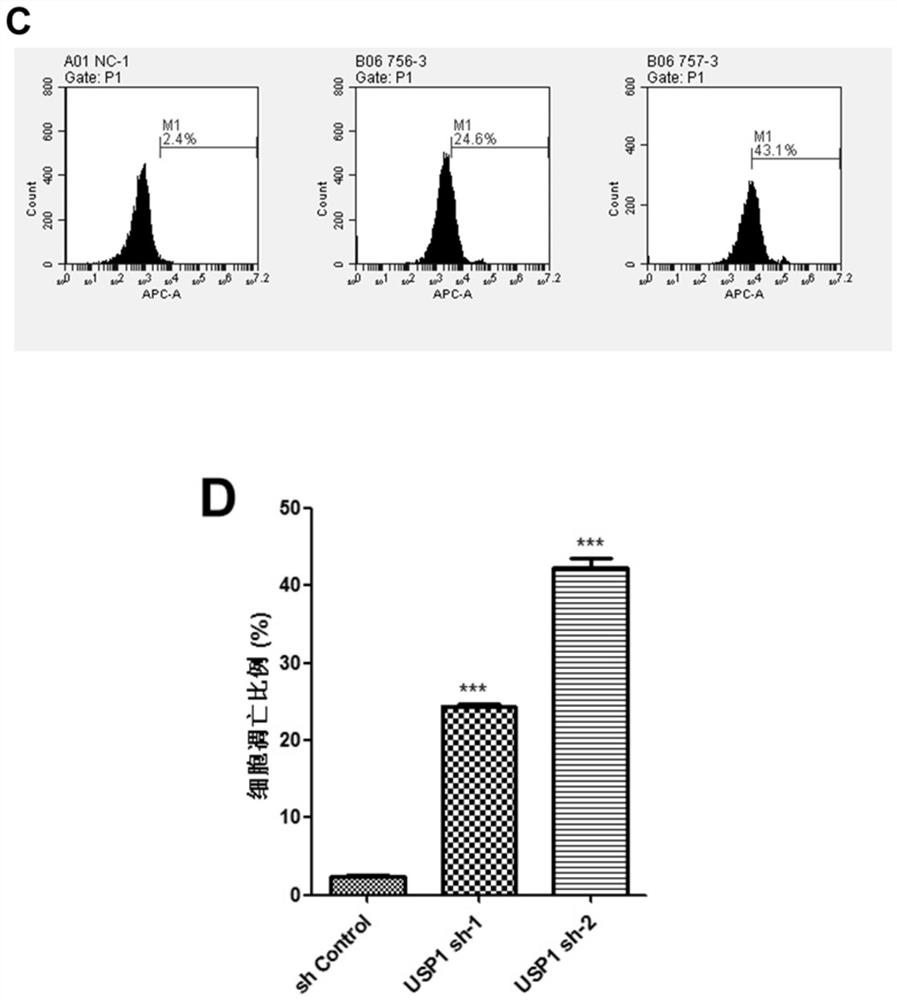Application of substance for reducing USP1 expression in preparation of medicine for treating children T-series acute lymphoblastic leukemia
A technology of acute lymphocytes and expression cassettes, applied in the field of biomedicine
- Summary
- Abstract
- Description
- Claims
- Application Information
AI Technical Summary
Problems solved by technology
Method used
Image
Examples
Embodiment 1
[0057] Example 1: Overexpression of the deubiquitinating enzyme USP1 in childhood T-ALL
[0058] 1. mRNA level overexpression
[0059] The NCBI GEO database (https: / / www.ncbi.nlm.nih.gov / geo) downloaded the gene expression profile results (GSE13159) of bone marrow samples from healthy children and children with T-ALL. Using T-Test analysis, we found that in The expression level of USP1 mRNA in children's T-ALL bone marrow samples (n=169) was significantly higher than that in healthy children's bone marrow samples (n=73, pfigure 1 Shown in A.
[0060] 2. Protein level overexpression
[0061] Use a heparin anticoagulant tube to extract 2ml of bone marrow cells from children with T-ALL, add 5ml of erythrocyte lysate and mix well, let it stand for 2 minutes, then centrifuge at 100g for 5 minutes, discard the supernatant and repeat the above steps, and then use normal saline to dilute the bottom of the tube. Wash the cells twice, remove the supernatant, and collect the cells.
...
Embodiment 2
[0064] Example 2: Construction of RNA interference recombinant expression vector of deubiquitinating enzyme USP1
[0065] 1. Selection of RNA interference target sequence
[0066] For the full-length cDNA sequence (SEQ ID NO: 14) of the deubiquitinating enzyme USP1 encoding gene USP1, the following two DNA sequences were selected as target sequences for RNA interference:
[0067] sh-1: the 2574-2594th position of SEQ ID NO: 14 (ie 5'-CCAGTGACCAAACAGGCATTA-3')
[0068] sh-2: the 2030-2050th position of SEQ ID NO: 14 (ie 5'-GCTAGTGGTTTGGAGTTTGAT-3')
[0069] Positions 422-2779 in SEQ ID NO:14 are open reading frames encoding the deubiquitinating enzyme USP1 shown in SEQ ID NO:15.
[0070] 2. Small interfering RNA (siRNA)
[0071] Two siRNAs, siRNA-1 and siRNA-2, were respectively designed for the two target sequences of the deubiquitinating enzyme USP1 in step 1, wherein the target sequence of siRNA-1 was sh-1, and the target sequence of siRNA-2 was sh- 2.
[0072] siRNA-1 ...
Embodiment 3
[0112] Example 3: Deubiquitinase USP1 RNA interference recombinant expression vector lentivirus infection of leukemia cells and Western blot detection of the expression of deubiquitinase USP1 in recombinant leukemia cells
[0113] 1. Deubiquitinating enzyme USP1 RNA interference recombinant expression vector lentivirus infection of leukemia cells
[0114] (1) RNA interference recombinant expression vector lentiviral packaging
[0115] The target gene GV493-USP1-sh-1, GV493-USP1-sh-2 or control sequence GV493-sh-Control plasmid, virus packaging helper plasmids pHelper 1.0 and pHelper2.0 (purchased from Shanghai Jikai Gene Medicine Technology Co., Ltd. ) to co-transfect 293T cells, and extract the supernatant 48-72 hours after the transfection to harvest the virus. Centrifuge at 4°C and 4000g for 10 minutes to remove cell debris; filter the supernatant with a 0.45 μm filter and put it into a 40ml ultracentrifuge tube; balance the samples separately, and put the ultracentrifuge ...
PUM
| Property | Measurement | Unit |
|---|---|---|
| molecular weight | aaaaa | aaaaa |
Abstract
Description
Claims
Application Information
 Login to View More
Login to View More - R&D
- Intellectual Property
- Life Sciences
- Materials
- Tech Scout
- Unparalleled Data Quality
- Higher Quality Content
- 60% Fewer Hallucinations
Browse by: Latest US Patents, China's latest patents, Technical Efficacy Thesaurus, Application Domain, Technology Topic, Popular Technical Reports.
© 2025 PatSnap. All rights reserved.Legal|Privacy policy|Modern Slavery Act Transparency Statement|Sitemap|About US| Contact US: help@patsnap.com



